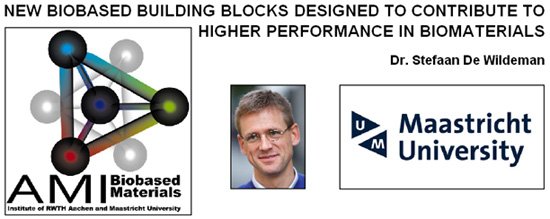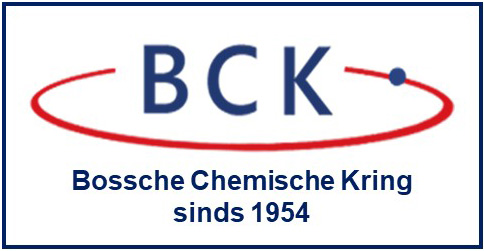| Datum |
Dinsdag 8 april 2014 |
||||
| Locatie | Rode Kruis Gebouw, Oude Dieze 12, 's-Hertogenbosch | ||||
| Aanvang |
|

Samenvatting
Greening the plastic world: how to do?
Most nowadays developments in biobased materials show an imbalance between synthesis and application driving forces. New biobased building blocks that are evident from nature are explored heavily to make them fit for materials applications – a challenge that often compares to making a weak horse strong. From the other side, strong desire to green blockbuster building blocks such as terephthalic acid and adipic acid with proven track record in materials, often ask for exhaustive synthesis efforts because there is no evident link to renewable sources.
Recently, the search for a more subtle balance between synthesis and application has been settled in new Institutes on one of Europe’s largest chemical production sites “Chemelot”: the Aachen-Maastricht Institute for BioBased Materials (AMIBM) and Institute for Science and Technology (InSciTe BioBased/BioMedical). “Would it be possible to come up with newly designed biobased building blocks that at the same time are connected to renewable sources via a few (surprising) (bio)chemical steps, while contributing to performance or even outperformance in materials?”
Bringing together industrial experts grown up in leading (bio)chemical companies (such as DSM, Teijin, Agfa-Gevaert and Fraunhofer) in Maastricht University, RWTH Aachen and Maastricht University join forces in AMIBM to organize world-class R&D programs towards new biobased polymers all along the value chain of (bio)synthesis, polymerization and material application development. Maastricht University is also founding father of InSciTe, where drop-in and new biobased building blocks and processes will be piloted.
Biocatalysis is one of the enablers and differentiators in accessing such new biobased building blocks: often those blocks were never in the hands of materials experts because they were not or hardly (low-cost) accessible from fossil resources.
Hot spots for such new biobased building blocks were meanwhile identified, opening new horizons for new biobased materials adding functionality in their Applications.
This lecture will give a taste and pinpoint to biocatalytic challenges of this young balancing act between historically splitted worlds: (bio)catalysis converting Nature’s products into new BioBased Building Blocks, polymerization of these blocks into polymers, followed by application development to address specific unmet needs in the market.
Keywords:
Biocatalysis and Innovative Synthesis / Polymerization / Compounding / Biobased Building Block / New biobased aromates / Renewable raw materials
Curriculum vitae Dr. Stefaan de Wildeman
Stefaan De Wildeman graduated as a Chemical Engineer in Applied Biological Sciences (Catholic University Leuven, 1998), and finished his Ph.D. after discovering a new bacterial species dehalorespiring chlorinated organic pollutants in groundwater (Ghent University / Friedrich-Schiller University Jena, 2002).
Since 2002, he joined DSM as an Associate Scientist in the field of Biocatalysis, one of DSM’s world-leading competences sustaining DSM businesses in Pharma, Anti-Infectives, Nutritionals, Vitamins and Plastic Materials. As a Senior Scientist, he has increaslingly explored the potential of biocatalysis to link renewable raw materials to new biobased building blocks for novel materials with added functionality.
In 2013, Stefaan started up a research group and strategic projects on new biobased building blocks at Maastricht University, serving two new Biobased Institutes (Aachen-Maastricht Institute for BioBased Materials (AMIBM) and Institute for Science&Technology (InSciTe), located at Chemelot in Southern of The Netherlands in close cooperation with regional academia and global industries.
De avond wordt besloten met een drankje. Introducé(e)s zijn van harte welkom.

